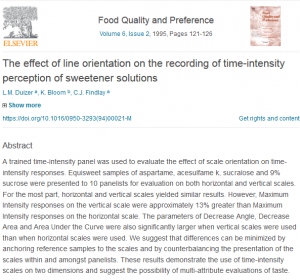The effect of line orientation on the recording of time-intensity perception of sweetener solutions
 A trained time-intensity panel was used to evaluate the effect of scale orientation on time-intensity responses. Equi-sweet samples of aspartame, acesulfame k, sucralose and 9% sucralose were presented to 10 panellists for evaluation on both horizontal and vertical scales. For the most part, horizontal and vertical scales yielded similar results. However, Maximum Intensity responses on the vertical scale were approximately 13% greater than Maximum Intensity responses on the horizontal scale.
A trained time-intensity panel was used to evaluate the effect of scale orientation on time-intensity responses. Equi-sweet samples of aspartame, acesulfame k, sucralose and 9% sucralose were presented to 10 panellists for evaluation on both horizontal and vertical scales. For the most part, horizontal and vertical scales yielded similar results. However, Maximum Intensity responses on the vertical scale were approximately 13% greater than Maximum Intensity responses on the horizontal scale.
The parameters of Decrease Angle, Decrease Area and Area Under the Curve were also significantly larger when vertical scales were used than when horizontal scales were used. We suggest that differences can be minimized by anchoring reference samples to the scales and by counterbalancing the presentation of the scales within and amongst panellists. These results demonstrate the use of time-intensity scales on two dimensions and suggest the possibility of multi-attribute evaluations of taste.
![]()
Duizer, L. M., Bloom, K., & Findlay, C. J. (1995). The effect of line orientation on the recording of time-intensity perception of sweetener solutions. Food Quality and Preference, 6(2), 121-126. http://dx.doi.org/10.1016/0950-3293(94)00021-M